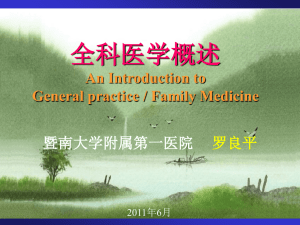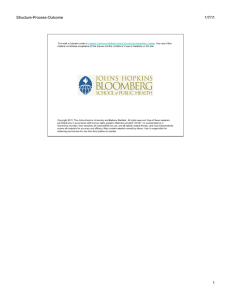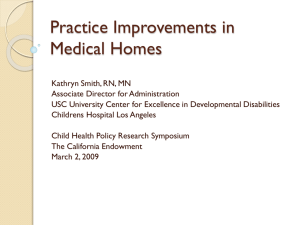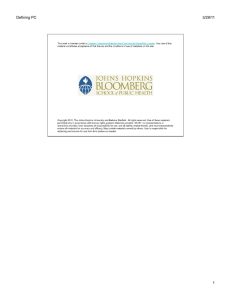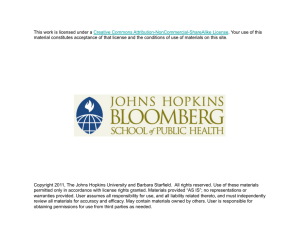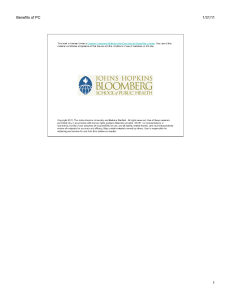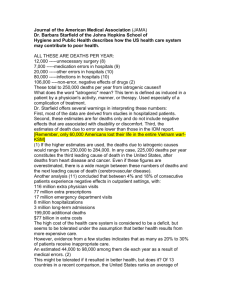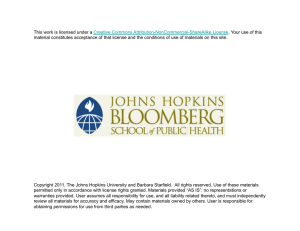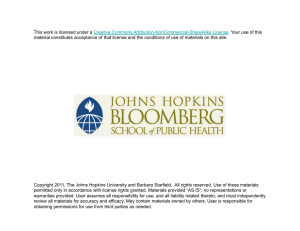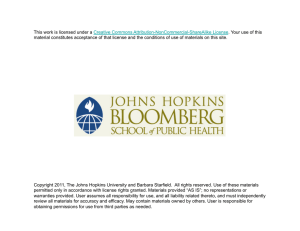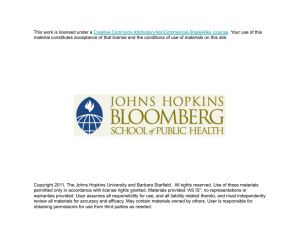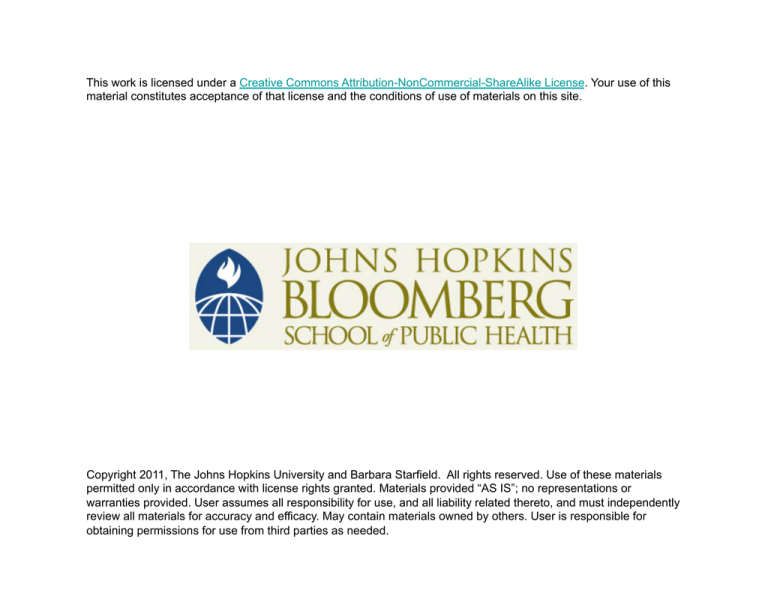
This work is licensed under a Creative Commons Attribution-NonCommercial-ShareAlike License. Your use of this
material constitutes acceptance of that license and the conditions of use of materials on this site.
Copyright 2011, The Johns Hopkins University and Barbara Starfield. All rights reserved. Use of these materials
permitted only in accordance with license rights granted. Materials provided “AS IS”; no representations or
warranties provided. User assumes all responsibility for use, and all liability related thereto, and must independently
review all materials for accuracy and efficacy. May contain materials owned by others. User is responsible for
obtaining permissions for use from third parties as needed.
Defining Primary Care
Barbara Starfield, MD, MPH
Primary Care Course
(Based on Cape Town, South Africa, 2007;
and Barcelona, Spain, 2009)
This presentation explains why
primary health care and primary
care are a worldwide imperative
and how they can be
conceptualized and measured
to provide accountability for
achievement in different areas
and countries.
Starfield 02/11
PCB 7458
Revolutions in Medicine, 1900s
Ascendance of single disease and chronic
illness focus
Diagnostic challenges/more technology
Single cause (? gene) – magic bullet
All fostered an INDIVIDUAL ORIENTATION
in health services.
Starfield 07/07
LINK 5937
Revolutions in Medicine, 2000s
Multiple interacting influences on illness/
health
Disparities in health (inequity)
Illness as morbidity burden, not as disease
Risk factors as diseases
Health as an impossibility (a healthy person
is someone without enough tests)
All require a POPULATION ORIENTATION.
Starfield 07/07
LINK 5938
Global Health Chart
Source: Karolinska Institute: www.whc.ki.se/index.php. All Rights Reserved.
Starfield 09/04
IC 5644 n
Life Expectancy Compared with GDP
per Capita for Selected Countries
Country codes:
AG=Argentina
AU=Australia
BZ=Brazil
CH=China
CN=Canada
FR=France
GE=Germany
HU=Hungary
IN=India
IS=Israel
IT=Italy
JA=Japan
MA=Malaysia
ME=Mexico
Starfield 11/06
IC 6440 n
Country* Clusters: Health Professional
Supply and Child Survival
Starfield 07/07
HS 6333 n
Relationship between Health Professional
Supply and Child Survival to Age 5
9
US
8
UK
CA
Under-5 Mortality
7
FR
6
NZ
AU
SP
5
BE
NE
FI
JP
GE
4
DE
NO
3
SW
2
1
0
0
5
10
15
20
25
30
Health Workforce Density
Derived from: Chen et al, Lancet 2004; 364:1984-90.
Starfield 12/04
HS 6332 n
Societal Influences on Population Health and Equity
COMMUNITY CONTEXT
notes continued on IH 6891 bn
ENVIRONMENTAL
CHARACTERISTICS
POLICY CONTEXT
OCCUPATIONAL &
ENVIRONMENTAL
POLICY
POLITICAL
CONTEXT
SOCIAL
POLICY
EQUITY IN
HEALTH*
WEALTH: LEVEL &
DISTRIBUTION
POWER/STATUS
RELATIONSHIPS
HISTORICAL
HEALTH
DISADVANTAGE
RATES OF DISCOMFORT
AND DISEASE
ECONOMIC
POLICY
BEHAVIORAL &
CULTURAL
CHARACTERISTICS
RATES OF DISABILITY
AND DEATH
HEALTH
POLICY
HEALTH SYSTEM
CHARACTERISTICS
Dashed lines indicate the existence of pathways through individual-level
characteristics that most proximally influence health.
Shading represents degree to which characteristics are measured at the ecological
level (lighter color) or at the individual level aggregated to community.
DEMOGRAPHIC
STRUCTURE
*“Health” has two aspects: occurrence
(incidence) and intensity (severity).
Starfield 01/08
IH 6891 an
Societal Influences on Population Health and Equity (continued)
COMMUNITY CONTEXT
notes continued from IH 6891 an
ENVIRONMENTAL
CHARACTERISTICS
POLICY CONTEXT
OCCUPATIONAL &
ENVIRONMENTAL
POLICY
POLITICAL
CONTEXT
SOCIAL
POLICY
EQUITY IN
HEALTH*
WEALTH: LEVEL &
DISTRIBUTION
POWER/STATUS
RELATIONSHIPS
HISTORICAL
HEALTH
DISADVANTAGE
RATES OF DISCOMFORT
AND DISEASE
ECONOMIC
POLICY
BEHAVIORAL &
CULTURAL
CHARACTERISTICS
RATES OF DISABILITY
AND DEATH
HEALTH
POLICY
HEALTH SYSTEM
CHARACTERISTICS
Dashed lines indicate the existence of pathways through individual-level
characteristics that most proximally influence health.
Shading represents degree to which characteristics are measured at the ecological
level (lighter color) or at the individual level aggregated to community.
DEMOGRAPHIC
STRUCTURE
*“Health” has two aspects: occurrence
(incidence) and intensity (severity).
Starfield 01/08
IH 6891 bn
Commission on Social Determinants of
Health Conceptual Framework
Source: WHO Commission on Social Determinants of Health. Closing the Gap in a Generation: Health
Equity through Action on the Social Determinants of Health. World Health Organization, 2008.
Starfield 05/09
IH 7139 n
The Commission on Social
Determinants of Health
Chapter 9: Universal health care
recommendations for national
governments
Source: WHO Commission on Social Determinants of Health. Closing
the Gap in a Generation: Health Equity through Action on the Social
Determinants of Health. World Health Organization, 2008.
Starfield 05/09
PC 7130
(Action area 1: build health-care
systems based on principles of equity,
disease, prevention, and health
promotion)
9.1 with civil society and donors, build
health care services on the principle of
universal coverage of quality services,
focusing on Primary Health Care
Source: WHO Commission on Social Determinants of Health. Closing
the Gap in a Generation: Health Equity through Action on the Social
Determinants of Health. World Health Organization, 2008.
Starfield 05/09
PC 7131
(Action area 2: ensure that the healthcare system financing is equitable)
9.2 ensure public sector leadership in
health-care system financing, focusing
on tax-based financing, ensuring
universal coverage regardless of ability
to pay, and minimizing out-of-pocket
payments
Source: WHO Commission on Social Determinants of Health. Closing
the Gap in a Generation: Health Equity through Action on the Social
Determinants of Health. World Health Organization, 2008.
Starfield 05/09
PC 7132
(Action area 3: build and strengthen the health
workforce and add capacities to act on the social
determinants of health)
9.3 with donors, increase investment in medical
and health personnel, balancing health worker
density in rural and urban areas
9.4 with international agencies and donors,
address the health human resources brain drain
focusing on investment in increased health human
resources and training, and bilateral agreements
to regulate gains and losses
Source: WHO Commission on Social Determinants of Health. Closing
the Gap in a Generation: Health Equity through Action on the Social
Determinants of Health. World Health Organization, 2008.
Starfield 05/09
PC 7133
Commission on Social Determinants of
Health, Health Systems Knowledge Network
1. The evidence base of the report
2. The health system as a social determinant of health and
health equity, and equity problems of health systems
3. Strengthen health systems to address health equity:
revitalize intersectoral action; promote social
empowerment; strengthen the redistributive role of
health care; revitalize Primary Health Care
4. Initiating and sustaining health system transformation:
national processes to institutionalize change;
international support for transformation
Source: Gilson et al, Challenging Inequity through Health Systems.
Final Report, Knowledge Network on Health Systems, June 2007.
WHO Commission on the Social Determinants of Health.
Starfield 05/09
PC 7134
Commission on Social Determinants of
Health, Health Systems Knowledge
Network
“Overall, experience suggests that redistributive
health care systems share five common features”.
1.
2.
3.
4.
5.
Universal coverage
Public funding plays a central role
No or very low fees are charged
Comprehensive services
Private sector complements the public sector if
there is effective contracting
Source: Gilson et al, Challenging Inequity through Health Systems.
Final Report, Knowledge Network on Health Systems, June 2007.
WHO Commission on the Social Determinants of Health.
Starfield 05/09
PC 7135
The World Health Report 2008:
Primary Health Care – Now More
than Ever
1. The challenges of a changing world
2. Advancing and sustaining universal
coverage
3. Primary Care: Putting people first
4. Public Policies for the public’s health
5. Leadership and effective government
6. The way forward
Source: World Health Organization. The World Health Report 2008: Primary
Health Care – Now More than Ever.
Starfield 05/09
PC 7129
The Sixty-second World Health Assembly
– WHA 62.12 – Agenda Item 12.4
22 May 2009
… Strongly reaffirming the values and principles of primary
health care, including equity, solidarity, social justice, universal
access to services, multisectoral action, decentralization and
community participation as the basis for strengthening health
systems … URGES member states:
1. to ensure political commitment at all levels …
2. to accelerate action towards universal access to primary
health care by developing comprehensive health services
and by developing national equitable, efficient and
sustainable financing mechanisms …
3. to put people at the centre of health care …
Starfield 05/09
PC 7136 n
The Sixty-second World Health Assembly
– WHA 62.12 – Agenda Item 12.4
22 May 2009 (continued)
4. to promote active participation …empowering communities,
especially women, in the processes of developing and
implementing policy and improving health and health care, in
order to support the renewal of primary health care
5. to train and retain adequate numbers of health workers, with
appropriate skill mix, including primary health care nurses,
midwives, allied health professionals, and family physicians
… in order to respond effectively to people’s health needs
6. to encourage that vertical programs (be) … integrated and
implemented in the context of integrated primary health care
Starfield 05/09
PC 7137
The Sixty-second World Health Assembly
– WHA 62.12 – Agenda Item 12.4
22 May 2009 (continued)
7. to improve access to appropriate medicines, health products,
and technologies, all of which are required to support primary
health care
8. to develop and strengthen health information and
surveillance systems, relating to primary health care … to
facilitate evidence-based policies and program and their
evaluation
9. to strengthen health ministries, enabling them to provide
inclusive, transparent and accountable leadership of the
health sector and to facilitate multisectoral action as part of
primary health care …
Starfield 05/09
PC 7138
A framework based on
structure, process, and
outcome is helpful in
describing and measuring
the components of health
services systems.
Starfield 10/07
HS 6849
Are there differences in
structure, process, and
outcomes that can explain
variability in health even
across areas with similar
wealth and resources?
Starfield 10/07
IH 6847
The Health Services System
CAPACITY
Provision
of care
PERFORMANCE
Personnel
Facilities and equipment
Range of services
Organization
Management and amenities
Continuity/information systems
Knowledge base
Accessibility
Financing
Population eligible
Governance
Problem recognition
Diagnosis
Management
Reassessment
Community
resources
Cultural and
behavioral
characteristics
People/practitioner interface
Receipt
of care
HEALTH STATUS
(outcome)
Biologic endowment
and prior health
Source: Starfield. Primary Care:
Balancing Health Needs, Services, and
Technology. Oxford U. Press, 1998.
Utilization
Acceptance and satisfaction
Understanding
Participation
Longevity
Comfort
Perceived well-being
Disease
Achievement
Risks
Resilience
Social, political,
economic, and
physical
environments
Starfield 02/09
HS 5064 n
Primary care is a major
component of health
services systems.
Starfield 10/07
HS 6850
Primary Health Care and
Primary Care
Primary health care is a system-wide
approach to designing health services
based on primary care.
Primary care is the representation, on
the clinical level, of primary health care.
Starfield 03/05
PC 6384
The framework of structure,
process, and outcome is
useful in defining primary
care so that it can be
measured and evaluated.
Starfield 10/07
EVAL 6856
Primary Care
First Contact
• Accessibility
• Use by people for each new problem
Longitudinal
• Relationship between a facility and its
population
• Use by people over time regardless of the type
of problem; person-focused character of
provider/patient relationship
Comprehensive
• Broad range of services
• Recognition of situations where services are
needed
Coordination
• Mechanism for achieving continuity
• Recognition of problems that require follow-up
Starfield 02/08
EVAL 5102 n
Primary Health Care Oriented Health Services Systems
CAPACITY
Provision
of care
PERFORMANCE
Receipt
of care
HEALTH STATUS
(outcome)
Biologic endowment
and prior health
Source: Starfield. Primary Care:
Balancing Health Needs, Services, and
Technology. Oxford U. Press, 1998.
Personnel
Facilities and equipment
Range of services
Organization
Management and amenities
Continuity/information systems
Knowledge base
Accessibility
Financing
Population eligible
Governance
Problem recognition
Diagnosis
Management
Reassessment
Community
resources
Cultural and
behavioral
characteristics
Population-Services interface
Utilization
Acceptance and satisfaction
Understanding
Participation
Longevity
Comfort
Perceived well-being
Morbidity burden
Achievement
Risks
Resilience
Social, political,
economic, and
physical
environments
Starfield 02/09
HS 6848 n
Measurement of Primary Care
• Primary care shares attributes with
other levels of care.
• Measurement of primary care should
address its unique functions.
• Measurement requires knowledge of
systems characteristics AND
behaviors.
Starfield, 4/97
Starfield 04/97
PCM 5111
The Health Services System: First Contact Components
Accessibility
CAPACITY
Provision
of
care
PERFORMANCE
Receipt of
care
Utilization
HEALTH STATUS
(outcome)
Source: Starfield. Primary Care: Balancing Health Needs,
Services, and Technology. Oxford U. Press, 1998.
Starfield 1999
HS 5369 n
The Health Services System: Longitudinality
Eligible population
CAPACITY
Provision
of
care
PERFORMANCE
People/practitioner interface
Receipt of
care
Utilization
HEALTH STATUS
(Outcome)
Source: Starfield. Primary Care:
Balancing Health Needs, Services, and
Technology. Oxford U. Press, 1998.
Starfield 1999
HS 5370 n
The Health Services System: Comprehensiveness
Range of services
CAPACITY
Provision
of
care
Problem recognition
PERFORMANCE
Receipt of
care
HEALTH STATUS
(outcome)
Source: Starfield. Primary Care:
Balancing Health Needs, Services, and
Technology. Oxford U. Press, 1998.
Starfield 1999
HS 5371 n
The Health Services System: Coordination
Information transfer
(Continuity)
CAPACITY
Provision
of
care
PERFORMANCE
Problem recognition
People/practitioner interface
Receipt of
care
HEALTH STATUS
(outcome)
Source: Starfield. Primary Care:
Balancing Health Needs, Services, and
Technology. Oxford U. Press, 1998.
Starfield 1999
HS 5372 n
Structural and Process Elements of the
Essential Features of Primary Care
Capacity
Accessibility
Essential Features
Performance
First-contact
Utilization
Eligible population
Longitudinality
Range of services
Comprehensiveness
Person-focused
relationship
Problem recognition
Continuity
Coordination
Starfield 04/97
EVAL 5107 an

